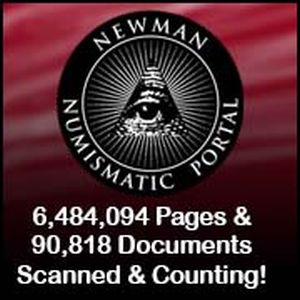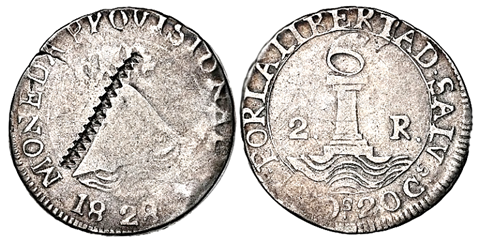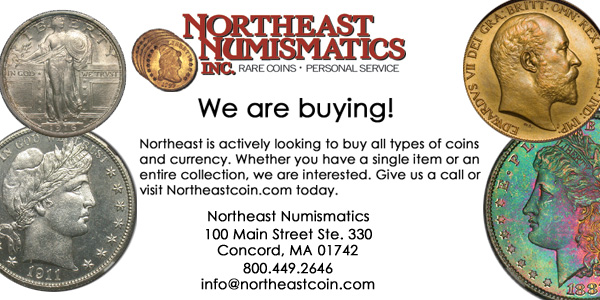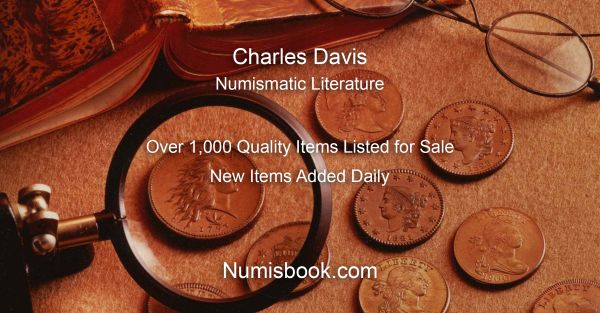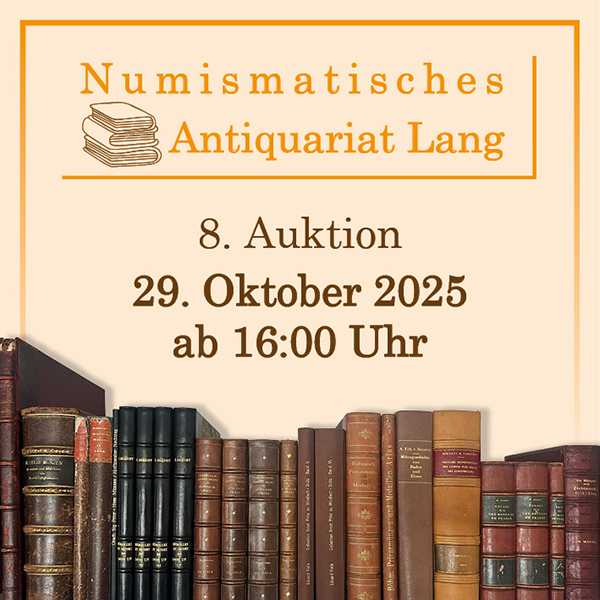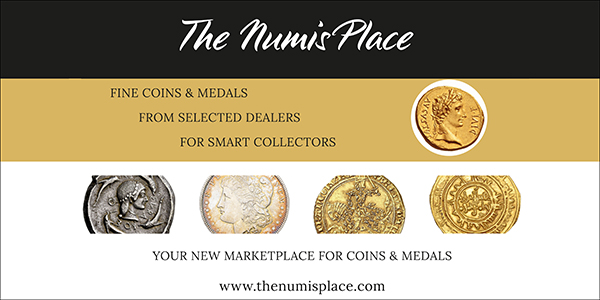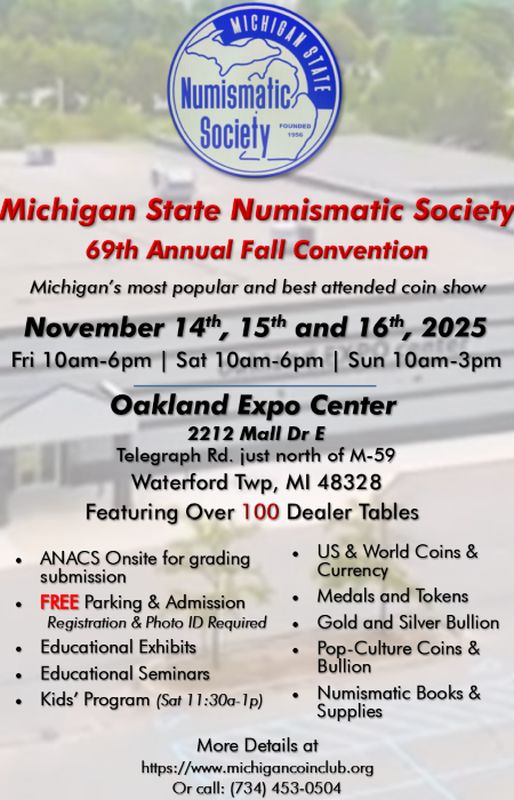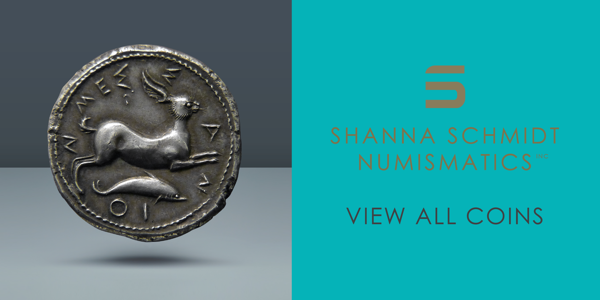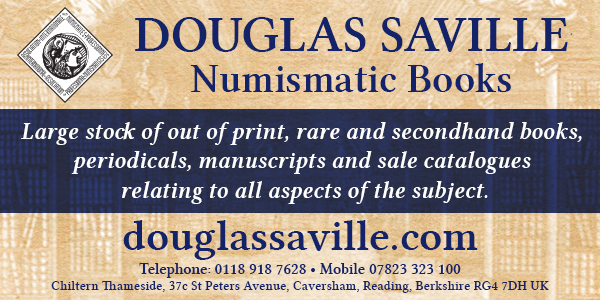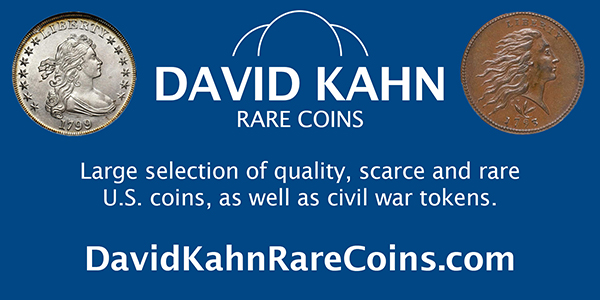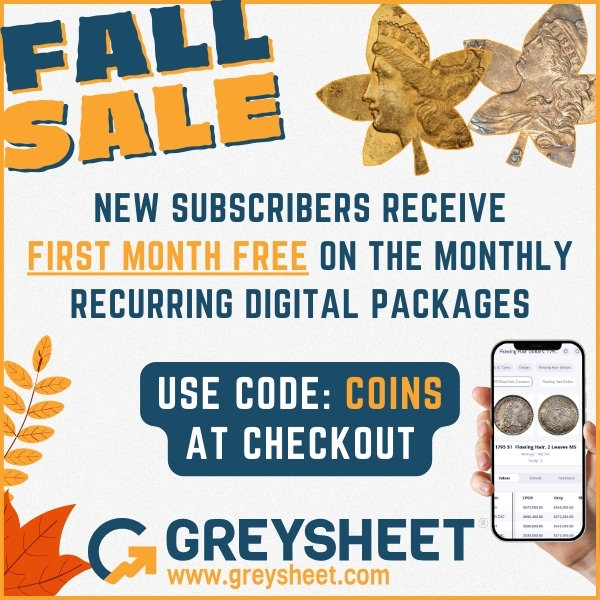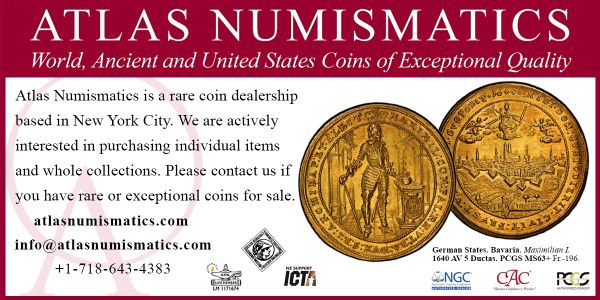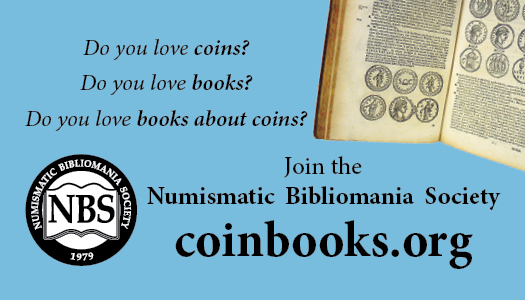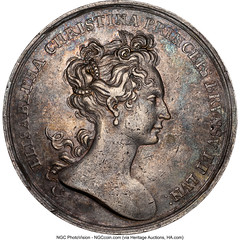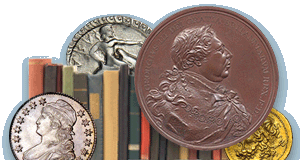
Visit our NBS Sponsors
About UsThe Numismatic Bibliomania Society is a non-profit association devoted to the study and enjoyment of numismatic literature. For more information please see our web site at coinbooks.org SubscriptionsThose wishing to become new E-Sylum subscribers can go to the following web page
Subscribe
MembershipThere is a membership application available on the web site Membership Application To join, print the application and return it with your check to the address printed on the application. Print/Digital membership is $40 to addresses in the U.S., and $60 elsewhere. A digital-only membership is available for $25. For those without web access, write to: Jeff Dickerson, Treasurer AsylumFor Asylum mailing address changes and other membership questions, contact Jeff at this email address: treasurer@coinbooks.org SubmissionsTo submit items for publication in The E-Sylum, write to the Editor at this address: whomren@gmail.com BUY THE BOOK BEFORE THE COINSale Calendar |
- WAYNE'S WORDS: THE E-SYLUM OCTOBER 19, 2025
- CHARLES DAVIS NEW NUMISMATIC LITERATURE STOCK
- LANG NUMISMATIC LITERATURE AUCTION 8 SELECTIONS
- NEW BOOK: MONEY OF THE MASSES
- NEW BOOK: COINS, RICHES, AND LANDS
- NEW BOOK: PRO RE. FESTSCHRIFT FOR BERNHARD PROKISCH
- NEW BOOK: MEDALLIONS: POLITICS AND GENEROSITY
- NEW BOOK: VICTOR HUSTER CATALOGUE RAISONNE
- PERIODICAL: ILNA DIGEST FALL 2025
- PERIODICAL: LOVE LETTER JUNE-AUGUST 2025
- PERIODICAL: SAMPLE SLAB UPDATE NEWSLETTER 44
- WORLD FOOD DAY
- VIDEO: MONEY SHOW OF THE SOUTHWEST
- NOTES FROM E-SYLUM READERS: OCTOBER 19, 2025
- QUERY: HOBART'S DENVER MINT BOOKLET
- C5 COLONIAL GROUP HOLDS OCTOBER 2025 LUNCH
- NOVEMBER 2025 WHITMAN BALTIMORE SHOW
- ANCIENT COINS DONATED TO UNIVERSITY
- VOCABULARY TERM: ROUNDED EDGE
- A NEW TYPE OF 1804 DOLLAR
- TREASURE TALK WITH BOB EVANS, EPISODE 8
- NUMISMAGRAM MEDAL SELECTIONS: OCTOBER 19, 2025
- STACK'S BOWERS: LATIN AMERICAN COINS
- HERITAGE: MEDALS AND TOKENS SHOWCASE
- WAYNE'S NUMISMATIC DIARY: OCTOBER 19, 2025
- THE EL SALVADOR ZIG-ZAG TEST MARK
- BUSINESSES ADJUST TO PENNY"S DEMISE
- 2026 MADISON COUNTY COIN CLUB MEDAL
- SYRIAN BANKNOTES TO FEATURE BRAILLE
- FUN 2004 FIREFIGHTERS EVERYDAY HEROES NOTES
- STAMP COLLECTION KERFUFFLE
- THE BIBLIOMANIA
- FEATURED WEBSITE: CASH IS FREEDOM
- ABOUT THIS ISSUE: OCTOBER 19, 2025
Content presented in The E-Sylum is not necessarily researched or independently fact-checked, and views expressed do not necessarily represent those of the Numismatic Bibliomania Society.
WAYNE'S WORDS: THE E-SYLUM OCTOBER 19, 2025
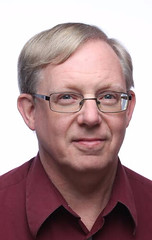 Thank you for reading The E-Sylum. If you enjoy it, please send me the email addresses of friends you think may enjoy it as well and I'll send them a subscription. Contact me at whomren@gmail.com anytime regarding your subscription, or questions, comments or suggestions about our content.
Thank you for reading The E-Sylum. If you enjoy it, please send me the email addresses of friends you think may enjoy it as well and I'll send them a subscription. Contact me at whomren@gmail.com anytime regarding your subscription, or questions, comments or suggestions about our content.
This week we open with numismatic literature sales, five new books, three periodicals, updates from the Newman Numismatic Portal, notes from readers, and more.
Other topics this week include copper coin circulation in India, medallions, medallic artist Victor Huster, sample slabs, and World Food Day.
To learn more about Baron Von Steuben medals, Hobart's Denver Mint booklet, rounded edges, a new type of 1804 dollar replica, fixed price and auction offerings, the "Hunger Taler", numismatic "fossils", Siege Currency, and the El Salvador Zig-Zag test mark, read on. Have a great week, everyone!
Wayne Homren
Editor, The E-Sylum
CHARLES DAVIS NEW NUMISMATIC LITERATURE STOCK
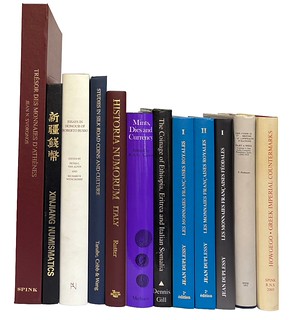 Numismatic literature dealer Charlie Davis writes:
Numismatic literature dealer Charlie Davis writes:
"We have recently purchased the book stock of a London firm that is no longer in the business of selling literature. We have listed approximately 60 titles to our Vcoins site and will be adding additional as time permits. We are generally pricing them at 20% or so less than our previous listing of the same title. We have multiple copies of many of the new titles, most that are second hand are one of a kind. We will have tables at the Manchester NH show October 23-25 and Baltimore November 5-7 and will have a selection of them at each show."
LANG NUMISMATIC LITERATURE AUCTION 8 SELECTIONS
REMINDER: The eighth numismatic literature auction from Numismatic Antiquarian Bookshop Lang closes October 29, 2025. Here are some additional selections. -Editor
We would like to remind you of our upcoming 8th auction for numismatic literature, which will take place on October 29, 2025.
You can look forward to an extensive and diverse selection: in addition to a comprehensive library on ancient numismatics, you will find numerous well-preserved works from the Middle Ages and modern times, as well as extensive series of auction catalogues.
- Details:
- Date: October 29, 2025
- Location: Online at Auex.de
- Start: 4:00 p.m. (CET)
Please remember to register in good time to participate in the auction. You can find our current PDF catalog at the link below. You can also find it on Auex.de and on our homepage.
Take this opportunity to get an overview of the diverse range of items on offer and place your favorites as advance bids.
Please do not hesitate to contact us if you have any questions.
NEW BOOK: MONEY OF THE MASSES
Kavan Ratnatunga passed along this new book on the use of small change in India. Thank you. The purchase link is for Amazon India - I was unable to find another seller. -Editor
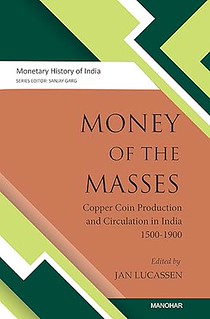 Money of the Masses: Copper Coin Production and Circulation in India, 1500-1900
Money of the Masses: Copper Coin Production and Circulation in India, 1500-1900
Jan Lucassen, Editor
Until very recently, the daily usage of coins by important parts of the population constituted an important indicator for the economic and social character of the society. Small denomination coins were produced and circulated primarily for the payment of wages, and of small purchases in market places and shops, where artisans and peasants offer their products. Frequent usage of small denomination coins thus allows us to characterise market societies as deeply monetised. This volume demonstrates that from the mid-sixteenth century Indian society was deeply monetized and in this respect it was not different from other major civilizations across Eurasia – from Western Europe via the West Asia to East Asia and back.
In order to reach these conclusions, a detailed study of the production of small denominations (mainly copper) is offered here, which will interest coin collectors and numismatists; next comes the circulation of this small change, important for monetary historians; and finally, the daily use, which points to social relations, their possibilities and restrictions, which is important for social and general historians. In addition, selections from contemporary archival records have been included in this volume which may serve as source material for future research.
NEW BOOK: COINS, RICHES, AND LANDS
The American Numismatic Society library has acquired a new book on medieval coins and money. -Editor
 A collection of academic papers studying how coins, riches and lands were gained and distributed among the soldiers, warriors, and mercenaries in the Antiquity and Early Medieval times.
A collection of academic papers studying how coins, riches and lands were gained and distributed among the soldiers, warriors, and mercenaries in the Antiquity and Early Medieval times.
Land was the ideal store of wealth in the ancient Mediterranean world. It brought social respectability, and its possession allowed participation in the politics of the cities governed by landowning elites. Crucial defense of the interests of a given polity through armed services often involved the distribution of lands to laborers still not integrated in these societies. Mediterranean urban dynamics also involved paid labor and were always in need of short-contract manpower, including skilled soldiers and warriors. For short-time military services, lands were not always available so soldiers and warriors were paid with coins and riches.
Because of their superior development, urban economies in the Mediterranean were able to attract migrant paid labor. When returning home, the migrant warriors carried coins and riches that would enable them to maximize the return that a homecoming entailed. Although difficult to prove whether these men were paid in advance or when discharged, it is an important issue as it shows the strength of one contractor over another and helps to better understand the construction of statehood in ancient and early medieval times.
NEW BOOK: PRO RE. FESTSCHRIFT FOR BERNHARD PROKISCH
Another new American Numismatic Society library acquisition is a collection of papers honoring the work of Dr. Bernhard Prokisch. -Editor
 The Austrian Research Society for Numismatics and the Society for Regional Studies and Monument Preservation of Upper Austria have joined forces to dedicate this Festschrift to Dr. Bernhard Prokisch on the occasion of his retirement. The title reflects one of the fundamental tenets of his professional and academic life—always PRO RE (always for the cause). The numerous and diverse contributions document his scholarly interests and work.
The Austrian Research Society for Numismatics and the Society for Regional Studies and Monument Preservation of Upper Austria have joined forces to dedicate this Festschrift to Dr. Bernhard Prokisch on the occasion of his retirement. The title reflects one of the fundamental tenets of his professional and academic life—always PRO RE (always for the cause). The numerous and diverse contributions document his scholarly interests and work.
Teachers, companions, colleagues and students of the honoree gathered for the presentation and acknowledged Bernhard Prokisch's extensive work.
The book is now available from the Austrian Research Society for Numismatics.
CONTENTS
THE BOOK BAZARRE
NEW BOOK: MEDALLIONS: POLITICS AND GENEROSITY
The new book Medallions: The Art of Politics and Generosity, published by Dumbarton Oaks, is available. Here's an overview and link to a PDF from the publisher's site. -Garrett
 Medallions: The Art of Politics and Generosity
Medallions: The Art of Politics and Generosity
By: Dumbarton Oaks
Medallions are among the most exquisite examples of Roman art from late antiquity surviving today. Distributed as gifts at imperial celebrations, they demonstrated an emperor's generosity at moments of personal, political, and military triumph. Their images and inscriptions acted as propaganda to bolster the imperial regime and advertise its strength, success, and virtue. They also show us what emperors thought people expected of them. For their recipients, medallions were a mark of social status and imperial favor. Displaying medallions received from the emperor asserted one's loyalty and place in the Roman hierarchy. As expressions of celebration and politics, favor and generosity, medallions offer us a glimpse of the intersection of art and empire at the end of the classical world.
Although they are neither medals nor coins, medallions share some features of both those objects. They were given out during great state celebrations against a backdrop of imperial pageantry. Medallions functioned as gifts, signifying imperial generosity, and as art, spreading state propaganda. Generosity was an important imperial trait, and gift giving was both a symbol of this quality and a chance to reward and bind power groups to the emperor and his family. Medallion designs, almost always featuring an imperial portrait on the obverse and a reference to an event, imperial virtue, or other family members on the reverse, were exquisite examples of the engraver's art designed to capture the majesty of the emperor's person and the benefits of his rule.
NEW BOOK: VICTOR HUSTER CATALOGUE RAISONNE
A Catalogue Raisonné of the work of German medallic artist Victor Huster, edited by Ursula Krauss, has just been released. Here's information from the press release. -Garrett
 Catalogue Raisonné 1972 to 2025
Catalogue Raisonné 1972 to 2025
Edited By: Ursula Krauss
The catalogue raisonné comprehensively documents the work of medallist and mint master Victor Huster over more than five decades. It lists over 1,400 works and systematically records all catalogue numbers. The different stages of coin minting in particular invite closer inspection.
Each individual motif is described in detail – both obverse and reverse – including technical details such as dimensions, materials, minting process and mintage. Where possible, the illustrations are reproduced in their original diameter and convey an authentic impression of the works.
PERIODICAL: ILNA DIGEST FALL 2025
Bruce Perdue became the editor of the Illinois Numismatic Association's ILNA Digest in 2024. Here's the latest issue. -Editor
Bruce writes:
"I moved it from a small format magazine to a full page large magazine. The membership's response has been positive. The membership is approximately 200 hard copy and roughly 125 digital members."
TABLE OF CONTENTS
-
 Words from President: John Kent
Words from President: John Kent
- Bicentennial Silver Dollar: William Birk
- Bourse Chairman Report: Steve Harrison
- Secretary/Treasurer Report: Jim Ray
- The 1992 XXV Olympic Half Eagle : Kevin Dailey
- Affordable Proof Mercury Dimes?: Mark Benvenuto
- In Memoriam
- Treasurer Report
- Interview With Nate Leonauskas: Cam Scheirer
- Local Meetings
- Board Minutes
- Archived Article: Seated Liberty Dime
- Citizens Bank [Continued]: Lucas Alan
- Webmaster/Editor: Bruce Perdue
- Advertising & Merchandise
- Upcoming Shows
PERIODICAL: LOVE LETTER JUNE-AUGUST 2025
Another recent club publication is the June/August 2025 issue of Love Letter from the Love Token Society, edited by LTS President Carol Bastable . -Editor
CONTENTS
PERIODICAL: SAMPLE SLAB UPDATE NEWSLETTER 44
The Sample Slab Update is published about every two months by David Schwager. Email him at davidschwager@hotmail.com to be added to the mailing list. The October 2025 issue (#44) has been published. It's a short, 9-page affair with news on the Volume 2, third edition of the Sample Slabs book by Schwager and Burton Strauss, an article noting that "Slab Collecting Is Now Mainstream", an interview with Schwager, and Buying and Selling sections.
With permission, we're reprinting the Mainstream article, which nicely "encapsulates" the progression of new specialty areas in numismatics. -Editor
WORLD FOOD DAY
Newman Numismatic Portal Project Coordinator Len Augsburger provided the following report on World Food Day and the United Nations Food & Agricultural Organization Money and Medal Programme. -Editor
World Food Day, October 16
The Food and Agriculture Organization (FAO) is a specialized agency of the United Nations that leads international efforts to defeat hunger. World Food Day is an international day celebrated every year worldwide on October 16 to commemorate the date of the founding of the United Nations Food and Agriculture Organization in 1945.
The FAO launched what would become the FAO Money and Medals Programme (MMP) in 1968. FAO issued collector art medals in various series to bring attention to FAO's goals and missions. This program was responsible for over a hundred medal designs issued to the collecting public. Eric P. Newman collected these pieces and over time accumulated a thick file of related materials.
VIDEO: MONEY SHOW OF THE SOUTHWEST
The David Lisot Video Library on the Newman Numismatic Portal can be found at:
https://nnp.wustl.edu/library/multimediadetail/522852
We highlight one of his videos each week in The E-Sylum. Here's one from 2009 with highlights of that year's Money Show of the Southwest Convention. -Editor
NOTES FROM E-SYLUM READERS: OCTOBER 19, 2025
More on Carl Schwenker
Jim Sandy of the Greater Houston Coin Club writes:
"The "Video: Looking at a Dollar Bill" brought back memories of Carl Schwenker who passed away in 2024. Carl's greatest numismatic feat was his complete set of Deep Mirror Proof-like Morgan dollars. He shared these in show and tells and presentations at the Greater Houston Coin Club's meetings. Arguably the top set in the nation, he eventually sold it to become part of the Del Loy Hansen collection! So it's a bit ironic to watch him teach about the paper dollar. But he truly cared for our late president Francis Townsend.
"Francis turned around a declining club. And he asked Carl to turn around a declining Houston Money Show. For ten years Carl was the driving force in that very successful effort. Today the show funds a wide range of educational activities including multiple full scholarships to the ANA Summer Seminar each year. And the club is still growing.
"After Francis' passing, GHCC began recognizing members for major contributions to the club and numismatics with its top award. It's named the Francis Townsend Service Award. Carl and his wife Pat are past winners. That really made Carl happy."
Thanks for the additional information on Carl, his collection and service to the hobby. -Editor
To read the earlier E-Sylum article, see:
VIDEO: LOOKING AT A DOLLAR BILL
(https://www.coinbooks.org/v28/esylum_v28n41a10.html)
Other topics this week include Justin's Stamping Stampede, Bill's Half Cent Headline Haze Baron Von Steuben medals, and Semiquincentennial $2.50 Coins. -Editor
QUERY: HOBART'S DENVER MINT BOOKLET
Roger Burdette poses an interesting question for U.S. researchers and bibliophiles. -Editor
Edwin L. Hobart's Denver Mint Booklet
According to a letter of July 10, 1914 Denver Mint Watchman E[dwin] L. Hobart prepared a booklet describing mint processes. He intended to sell the booklet to mint visitors and had talked with the Superintendent's personal secretary about the booklets. No one told him that employees were prohibited from selling pamphlets or souvenirs at the mint. He had 1,000 copies printed plus an advertising flyer, and was preparing to sell booklets when he was advised to get permission from mint director George Roberts.
Hobart wrote to Roberts who replied to Denver Mint Superintendent Thomas Annear that he would grant Hobart permission to sell the booklet ––
"In view of the fact which is not questioned, that Mr. Hobart was acting in good faith and
without knowledge that what he proposed to do was contrary to the rules, I am disposed to allow
him to sell the edition of 1000 copies which he has had printed on condition that the public shall
not be solicited to buy, and that the attention of visitors shall be directed to the pamphlet in an
entirely unobjectionable manner."
[RG104 E-235 Vol 403]
C5 COLONIAL GROUP HOLDS OCTOBER 2025 LUNCH
The Thursday Lunch Club has been meeting in New Jersey on an informal basis to discuss their common interest in colonial numismatics - coins, medals and paper. The group now has a formal name - Colonial Coin and Currency Club of NJ and PA (C5 for short). Congratulations! Roger Moore submitted this report on their recent meeting. -Editor
The gray heads had a meeting of C-5 (Colonial Coin and Currency Club of NJ and PA) on October 16, 2025, at the Town and Country Diner in Bordentown, NJ. In attendance from left to right around the table were: Leo Shane, Ray Williams, Bill Liatys, Wayne Shelby, Mike Brooks, John Louis, Don Hartman, Roger Siboni, and Roger Moore. After a brief period of exchanging condolences on our latest medical challenges, we moved on to showing interesting coins, etc.
NOVEMBER 2025 WHITMAN BALTIMORE SHOW
The Whitman Expo returns to Baltimore from November 6–8, 2025. Here is the press release. -Garrett
Whitman Expos™ proudly announces the return of the Winter Coin Expo, taking place November 6–8, 2025, at the Baltimore Convention Center. Recognized as one of the leading coin and collectibles expos in North America, the Whitman Expos Winter Coin Expo consistently draws collectors, dealers, and enthusiasts from across the country for three exciting days of buying, selling, trading, and discovery.
Open to the public with free admission (photo ID required), the Expo offers a welcoming environment for seasoned collectors, families, and newcomers alike. From valuable rarities to everyday treasures, visitors will explore an unparalleled selection of coins, paper money, and collectibles guided by independent dealers and numismatic experts.
Auctions and Special Features
Stack's Bowers Galleries, the renowned numismatic dealer founded in 1933, and who held its first auction sale in October 1935, will display lots from their upcoming Showcase Auction, the Official Auction of Whitman Expos, as well as highlights from future sales. A newly discovered specimen of the 1804 dollar, the "King of American Coins" with a pre-sale estimate of $4-5 million, will be on view, along with other historic and valuable properties including:
- Two of the largest United States gold coins ever made, the famous Gold Rush-era $50 slug, and the rare octagonal 1915 $50 gold coin that commemorated it.
- The faceplate of a gold ingot from the California Gold Rush, salvaged from an 1857 shipwreck and whose original weight would have contained over $1 million worth of gold at today's prices.
- Historic Maryland paper money, including issues from local banks and the rare 1775 "Gunpowder" note that was Maryland's first Revolutionary money ever.
- Rare Maryland colonial coins struck in the 1600 and 1700s.
- Historic American medals, including a medal made in 1801 for presentation to Indian chiefs by Lewis and Clark and another given to a pilot who saved Antarctic explorers in 1935.
- An example of the first American silver dollar worth more than $3 million, and a very rare 1969-S Doubled Die Obverse cent found in a bag of cents, that is worth $20,000.
On Friday, November 7 from 12 p.m. to 2 p.m. Dr. Fred Bart and Bianca Bart authors of United States Paper Money Errors, 5th Edition, will host a book signing at Booth #135. The newly revised and expanded reference—now in full color—includes more than 550 photos, detailed grading and pricing information, the Friedberg Numbering System™, rarity guides, and exclusive data on production errors within the Bureau of Engraving and Printing. Copies will be available for purchase at the show.
ANCIENT COINS DONATED TO UNIVERSITY
New York physician David Menchell donated 38 ancient coins to University of Massachusetts at Lowell for use in classes, including History Assistant Professor Jane Sancinito's classes. -Garrett
At the end of a talk for the American Numismatic Society on using coins in the classroom, History Assistant Professor Jane Sancinito made an appeal to collectors who find fakes mixed in with real coins they have bought at auction.
"Please remember your local universities," Sancinito said. "Many of us would love to have replicas that we could bring into classrooms and hand to students, because replicas are usually the right weight, they're the right size, and they have all the decoration of the originals."
VOCABULARY TERM: ROUNDED EDGE
Here's another entry from Dick Johnson's Encyclopedia of Coin and Medal Terminology. -Editor
Rounded Edge. The edge of a medallic item without sharp corners forming an arc between the two sides. Small medals can be diestruck with such an edge, but generally these are turned on a lathe to remove the corner angles. Although the rounded edge is somewhat more pleasing to the eye, such edge treatment does make the medal more difficult to hold and handle with human fingers. It should never be done on a medal larger than four-inch diameter. See edge, polished edge.
A NEW TYPE OF 1804 DOLLAR
E-Sylum Feature Writer and American Numismatic Biographies author Pete Smith submitted this article suggesting a new term for a type of 1804 dollar replica. Thank you. -Editor
I ended my article last week with a list of terms for the 1804 dollars. This week I will propose a new term.
Three items sold on eBay last week that got my attention. They were listed under the title of "1804 UNITED STATES LIBERTY TRADE DOLLAR RARE SILVER COIN." The three listings used the same photos and same PCGS certification numbers. The PCGS type number is not valid. The serial number was assigned to an MS-69 Silver Eagle.
Two of these sold on October 8 with the third selling on October 9. Each sold for $9.99 which is probably a fair price considering the cost of production in China. If it was silver, the melt value would be around $45.
TREASURE TALK WITH BOB EVANS, EPISODE 8
In January, our good friend Bob Evans began publishing a series of blog articles on the Finest Known website detailing his experience as co-discoverer and curator of the treasures recovered from the wreck of the S.S. Central America. Subject of the book "Ship of Gold", many exhibits, countless interviews and articles, books and auction catalogs feature the legendary haul of gold coins, bars, nuggets, gold dust and more from the 1857 shipwreck. Here's another excerpt - see the complete article online. -Editor
 Almost all the SSCA gold was stained, encrusted, or even enclosed with rust and limestone. These minerals were stable only where they formed, at the bottom of the ocean. Once brought into different conditions at the surface they became unstable and began to flake and spall off gold coins and ingots in unattractive ways.
Almost all the SSCA gold was stained, encrusted, or even enclosed with rust and limestone. These minerals were stable only where they formed, at the bottom of the ocean. Once brought into different conditions at the surface they became unstable and began to flake and spall off gold coins and ingots in unattractive ways.
So, the decision was made to remove all the unstable minerals obscuring the beautiful gold, except in a very few instances. This also allowed the coins to be third-party graded and encapsulated, and for the ingots to be handled without a rusty mess ending up on the handlers' skin and clothing.
NUMISMAGRAM MEDAL SELECTIONS: OCTOBER 19, 2025
Numismagram's Jeremy Bostwick sent along these four medals from his most recent upload of spooky material material to his site. For all of the new items, please visit https://www.numismagram.com/inventory. -Garrett
102717 | NETHERLANDS. Amsterdam. Surgeon's Guild cast brass Toegangspenning (Admission Token). Issued 1654, and used for the passing of the surgeon's exam/admission to the medicinal garden (45mm, 29.30 g, 12h). Skeleton (Grim Reaper) standing facing, holding scythe and resting hand upon hourglass on base to right; flowers at feet // Civic coat-of-arms of Amsterdam; below, field left blank for engraving; all set upon decorative cartouche, with skull at the bottom. Edge: Plain. Koning p. 46, 6.2; Dirks I.5.7; cf. Brettauer 5198. About Uncirculated. Brassy-olive surfaces, with a few stains noted near the rims. A rare and interesting medicina in nummis type. Compare to a similar example (also unengraved) that realized a total of $2,640 in the Stack's Bowers October 2021 CCO (lot 72539). $1,965.
STACK'S BOWERS: LATIN AMERICAN COINS
Stack's Bowers will be hosting their October 2025 Collectors Choice Online Auction of Latin American Coins & Paper Money on October 20-24. Select items are discussed below. -Garrett
MEXICO. 8 Escudos, 1760-Mo MM. Mexico City Mint. Charles III. NGC AU-55. Fr-25; KM-153; Onza-740 ("muy rara"). Two-year type. The first year of Charles III coinage, designed with the order around Charles III's neck extending below his bust. Attractive throughout, this piece shows centers that are evenly presented and sharp legends that are accompanied by dappled copper-orange tone in places. Very few individually mentionable marks appear for the grade. Altogether, far exceeding most seen, with its second-finest-graded status further validating the quality.
HERITAGE: MEDALS AND TOKENS SHOWCASE
Heritage Auctions will be hosting their Medals & Tokens Showcase Auction on October 20. Select items are discussed below. -Garrett
Brunswick-Wolfenbüttel. Anton Ulrich silver "Elisabeth Christine - Journey to Spain" 1707-Dated AU53 NGC, Brockmann-360. Diademed bust of Elisabeth Christine right // Three-mast ship sailing out to sea, with horse and EC monogram at stern. NGC Top Pop.
Elisabeth Christine, granddaughter of Anton Ulrich, was engaged to the future Charles VI, Holy Roman Emperor, from the age of 13. Her travel to Spain was intended as the date inscribed, though was delayed until the following year. They wed in August 1709, in the midst of the War of Spanish Succession. Charles VI would be crowned Emperor in 1711, and Elisabeth Christine would prove the longest serving Holy Roman Empress. She would become the mother of Empress Maria Theresa, and grandmother to Marie Antoinette, and two Holy Roman Emperors, Joseph II and Leopold II.
WAYNE'S NUMISMATIC DIARY: OCTOBER 19, 2025
I left the house about 7am Wednesday and pointed my car toward Pittsburgh, where I would attend the Pennsylvania Association of Numismatists (PAN) show on Thursday and Friday. Wednesday was a travel and fun day. After arriving in Monroeville, having some lunch and checking onto my hotel, I decided to get in a walk before meeting my sister for dinner.
I hadn't planned this, but something told me to go to an old stomping ground - North Park, where I walked a five-mile trail around the lake like I'd done in my younger days living in Pittsburgh. It was a beautiful fall day and I took this photo shortly after setting out.
THE EL SALVADOR ZIG-ZAG TEST MARK
Roberto Jovel published a paper in the Numismatics International Bulletin, volume 60, number 9/10 on the Zig Zag test mark on El Salvador Provisional coins (1828 through 1835). -Editor
Roberto writes:
"In recent years, several coins were auctioned that allegedly belong to El Salvador because they bear a ZigZag test mark, and have sold for very high prices. In fact, many of those were not tested and marked in El Salvador, and the persons who bought them find themselves owning pieces that are not Salvadorian.
I began researching El Salvador numismatic history in the mid 1990s and have published several books on the subject; after seeing the latest auction sales of the alleged Salvadorian coins, I decided to prepare a paper that tries to set the record straight."
BUSINESSES ADJUST TO PENNY'S DEMISE
Len Augsburger passed along this New York Times article about how some businesses are reacting to the cent's disappearance. -Editor
 Earlier this year, the U.S. Treasury Department announced that it was winding down the production of the penny, which long ago began costing more to make than it's worth. Several Federal Reserve Bank sites around the country, which distribute the coins to banks and credit unions, have already stopped fulfilling orders for pennies.
Earlier this year, the U.S. Treasury Department announced that it was winding down the production of the penny, which long ago began costing more to make than it's worth. Several Federal Reserve Bank sites around the country, which distribute the coins to banks and credit unions, have already stopped fulfilling orders for pennies.
This is putting some retailers in a bind, especially when customers don't have exact change for transactions that are not rounded to the nearest nickel.
This month, a consortium of retail groups, including the National Association of Convenience Stores and the National Grocers Association, wrote to members of Congress urging clear guidelines on how to proceed. The groups called for legislation to round transactions to make it easier to give exact change, and to facilitate check cashing at stores.
2026 MADISON COUNTY COIN CLUB MEDAL
Harold Fears of the Madison County Coin Club passed along this information about the club's new medal. -Editor
The Madison County Coin Club of Huntsville, Alabama, is issuing very special club medals to commemorate their 25th anniversary in 2026. The club has commissioned renowned engraver and artist Daniel Carr, proprietor of the Moonlight Mint of Loveland, Colorado, to produce the pieces. The medals' main motifs mimic Robert Scott's early 19th century coins featuring a draped bust obverse with heraldic eagle reverse. The medals have additional obverse and reverse inscriptions around the rim that read MADISON COUNTY COIN CLUB / HUNTSVILLE ALABAMA and EDUCATION * PUBLIC SERVICE * FELLOWSHIP / 2001-2026 25th ANNIVERSARY, respectively.
SYRIAN BANKNOTES TO FEATURE BRAILLE
The Central Bank of Syria has decided to include raised tactile printing on the country's upcoming banknote series to help blind and visually impaired people independently distinguish denominations, according to Governor Abdul Qader Hasriyeh. -Garrett
Hasriyeh said on Wednesday, October 15, that "in a long-overdue humanitarian step, we decided to include raised (embossed) printing on the new Syrian currency so that blind and visually impaired individuals can recognize denominations easily and independently," adding that the issue has personally concerned him as a "citizen" who cares about inclusion and the rights of persons with disabilities.
Qabawat: Braille on currency is a humanitarian demand
FUN 2004 FIREFIGHTERS EVERYDAY HEROES NOTES
Bob Bednar passed along this information about the Firefighters Everyday Heroes souvenir notes he exhibited at the 2004 FUN show. This grew out of an earlier discussion we had about banknote security features visible under UV light. Thanks! -Editor
STAMP COLLECTION KERFUFFLE
This article reveals a consignment kerfuffle in the stamp world. There must have been disputes like this in the world of coins - can anyone tell us about one? -Editor
 A Floridian widow is demanding that a Manhattan auction house return her husband's stamp collection, which is reportedly worth up to $2 million.
A Floridian widow is demanding that a Manhattan auction house return her husband's stamp collection, which is reportedly worth up to $2 million.
Shelley Entner wants the collection back because she claims some stamps are missing.
Her late husband, Stanley Marks, started collecting stamps in 1937, when he was just 16 years old, the New York Post reports. He continued amassing the stamps until his death in 2016 at the age of 89. The collection was then turned over to Robert A. Siegel Auction Galleries, which describes itself as the "world's leading auctioneer of US and worldwide stamps" on its website.
THE BIBLIOMANIA
For biblophiles (and those who make fun of us), Andy Newman passed along this excellent 2016 Atlas Obscura article on Bibliomania, "the Dark Desire For Books That Infected Europe in the 1800s." -Editor
 Dr. Alois Pichler was almost always surrounded by books. In 1869, Pichler, originally from Bavaria, became the so-called "extraordinary librarian" of the Imperial Public Library in St. Petersburg, Russia, a prestigious position that gave him a salary three times higher than the average librarian: 3,000 rubles.
Dr. Alois Pichler was almost always surrounded by books. In 1869, Pichler, originally from Bavaria, became the so-called "extraordinary librarian" of the Imperial Public Library in St. Petersburg, Russia, a prestigious position that gave him a salary three times higher than the average librarian: 3,000 rubles.
While many librarians have a deep appreciation for books, Pichler was afflicted with a specific irrepressible illness. A few months after Pichler took his position at the library, the staff discovered that an alarming number of books were disappearing from the collection. They suspected theft. Guards noticed that Pichler had been acting strangely—dropping books by the exit and hurriedly returning them to the shelves, refusing to remove his large overcoat, leaving the library several times within a day—and started paying close attention to him.
FEATURED WEBSITE: CASH IS FREEDOM
This week's Featured Website is CashIsFreedom.uk, passed along by Kavan Ratnatunga.
We're raising public awareness about the UK Government's plan to bring in a Central Bank Digital Currency (CBDC), and get rid of cash eventually. Find out how you can stop it and help the campaign.
Banks have been nudging us towards a cashless society for decades... First introducing credit cards in the 1960s, then debit cards, chip and pin, contactless and smartphone pay apps.
Now we are ?nally at the precipice of an all-digital PROGRAMMABLE currency, and once cash is gone it won't be coming back.
https://www.cashisfreedom.uk/
ABOUT THIS ISSUE: OCTOBER 19, 2025
With Monday being a Federal holiday I got another head start on the issue this week. Having been called back to the office, I worked on Tuesday. But I spent the rest of the workweek in Pittsburgh for the PAN Show and a visit with my sister. See my Diary article elsewhere in this issue for more.
When I have time I like to expend some brainpower on wordsmithing alliterative headlines. "Justin's Stamping Stampede" is all mine, but I asked AI for help to get to "Half Cent Headline Haze." "give me a word for consternation that starts with an h" came back with "horror," but that felt too strong. "give me a word for confusion that starts with an h" produced Havoc, Hodgepodge, Hubbub and Haze. The last one seemed the best fit.
Finally, here are some interesting non-numismatic articles I came across this week.
Malcolm McLean: Unsung Innovator Who Changed the World
(https://americanbusinesshistory.org/malcolm-mclean-unsung-innovator-who-changed-the-world/)
Library is Rescuing Historical Treasures Trapped on Old Floppy Disks from the ‘Digital Dark Ages'
(https://www.goodnewsnetwork.org/library-is-rescuing-historical-treasures-trapped-on-old-floppy-disks-from-the-digital-dark-ages/)
Let's talk about AI art
(https://theoatmeal.com/comics/ai_art)
-Editor

